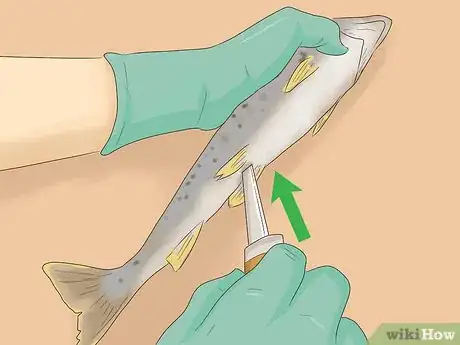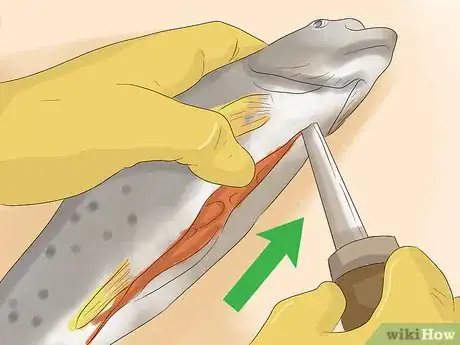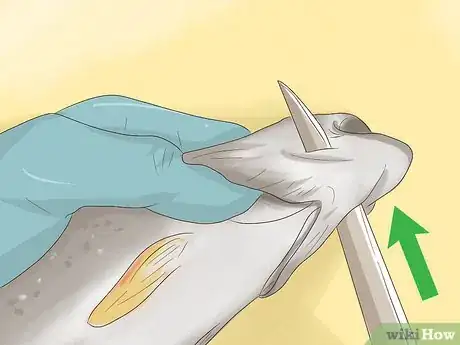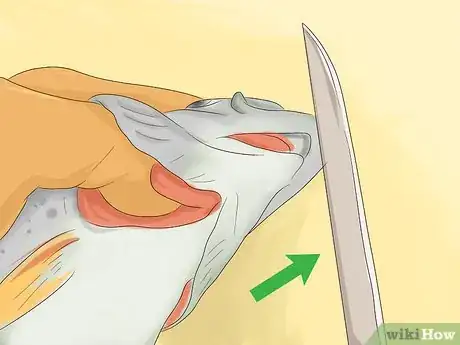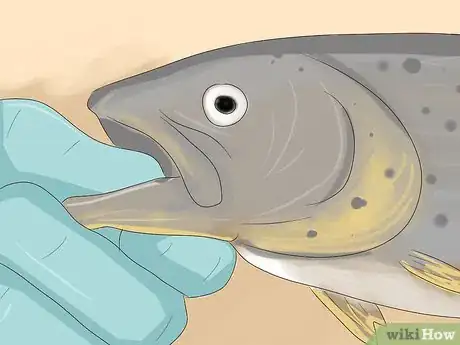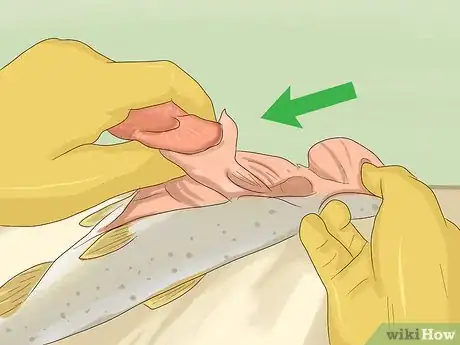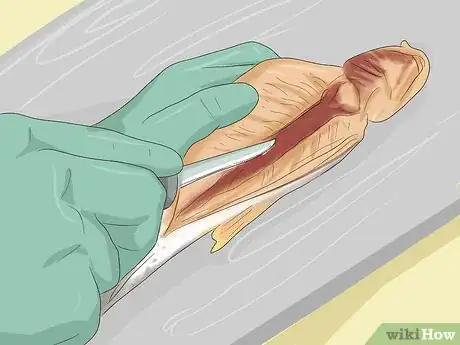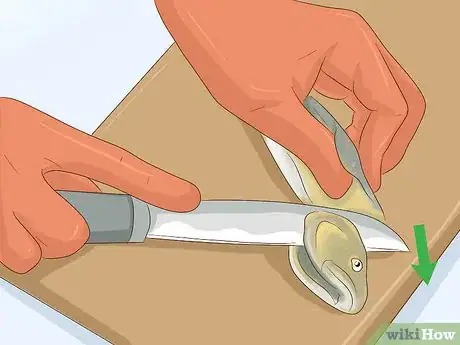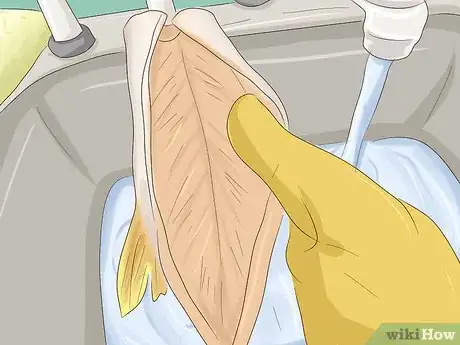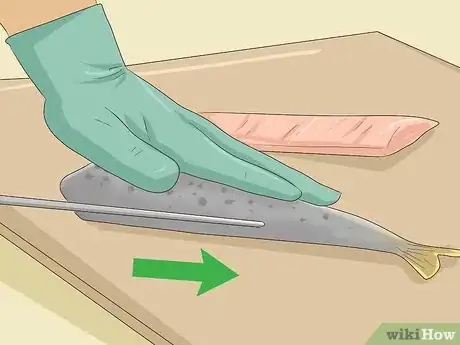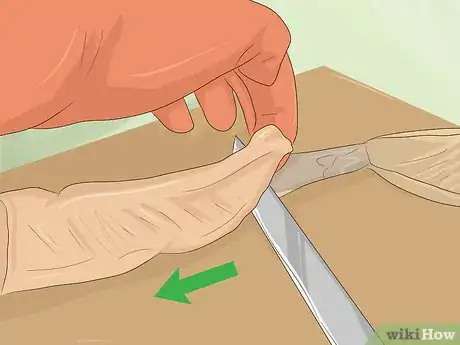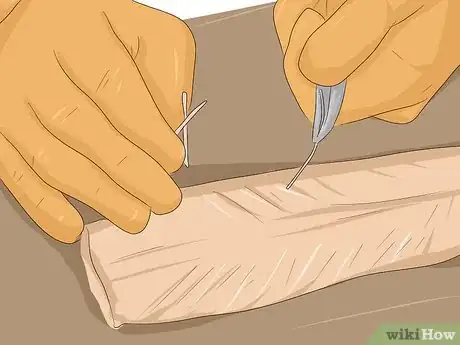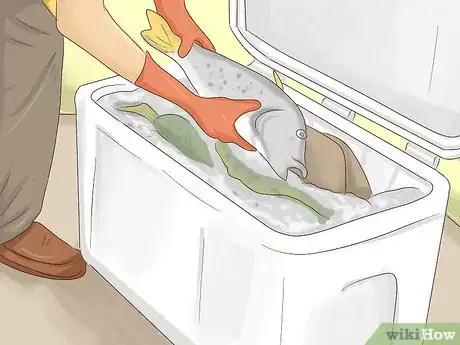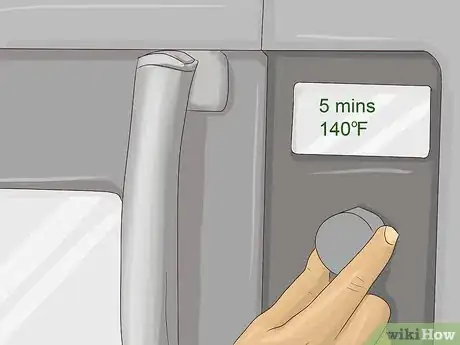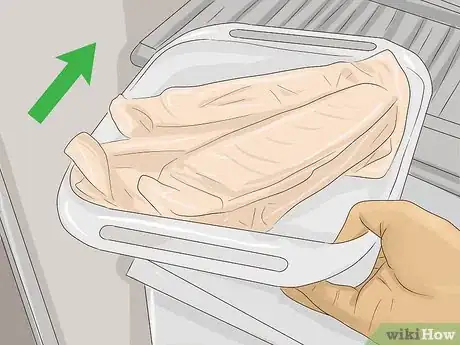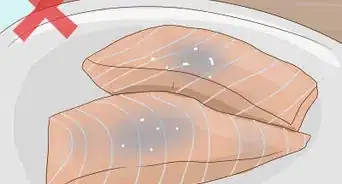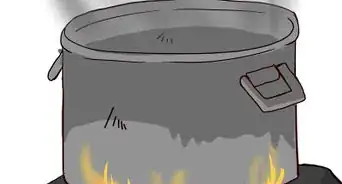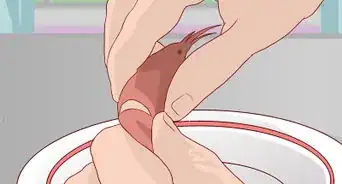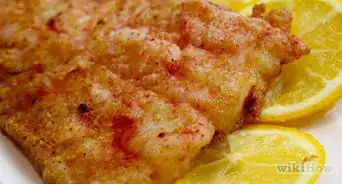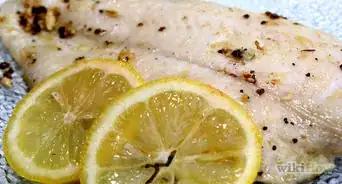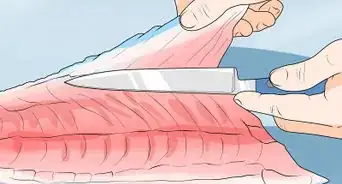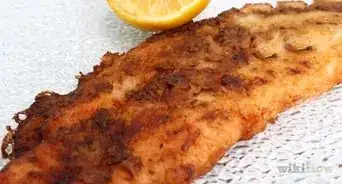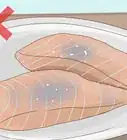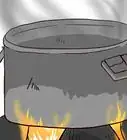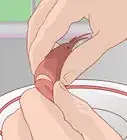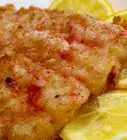This article was co-authored by wikiHow Staff. Our trained team of editors and researchers validate articles for accuracy and comprehensiveness. wikiHow's Content Management Team carefully monitors the work from our editorial staff to ensure that each article is backed by trusted research and meets our high quality standards.
There are 14 references cited in this article, which can be found at the bottom of the page.
This article has been viewed 19,259 times.
Learn more...
A hefty load of trout makes a great payoff after a long day on the river, but before you can fry them up, you’ll have to see that they’re properly cleaned. Dressing a trout is easier than you might think. With only a trusty knife and a cutting board you can have your catch gutted, filleted and ready for the pan in a matter of minutes. Simply cut the fish up through the middle of the belly, then open up the jaw and use it to pull away the entrails and other messy bits in one easy motion.
Steps
Making the Initial Cuts
-
1Insert the tip of your knife into the exit hole. Hold the trout by its dorsal edge and turn it over to expose the belly. You’ll find the exit hole near the tail end of the fish just under the lower fins. Point the blade toward the head, then slide it in smoothly.[1]
- To dress a fish quickly and efficiently, it’s important to use a sharp filleting knife that offers a little flexibility. This will allow you to make more precise cuts.[2]
- You’ll be exposed to blood, excrement and other bodily tissues while cleaning trout. It's a good idea to wear rubber gloves to protect you from germs.
-
2Cut the trout up through the belly. Run the knife along the length of the fish, stopping just before you reach the head. This cut doesn’t need to be very deep—just apply enough pressure to get through the soft skin on the underbelly without damaging the internal organs.[3]
- Be extremely careful when handling the knife, as you’ll be cutting in the direction of your opposite hand.
- Keeping the organs intact while you open the belly will make them easier to remove later on.
Advertisement -
3Use your knife to pierce the underside of the jaw. Hold the trout upright and stick the blade of the knife straight through the jaw beneath the lower “lip.” Keep pushing it until it comes out the other side. The blade should be situated above the tongue but below the jawbone itself.[4]
- Be sure to start on the side closest to you so you’re moving the blade away from yourself.
- Use a slight back and forth motion to help work the blade through the tough skin around the jaw.
-
4Slice through the jaw towards the mouth. Push the blade forward until it cuts clean through the tissue of the jaw. There should now be a small flap hanging down beneath the mouth of the trout. You’ll use this opening as a fingerhold to strip away the entrails.[5]
- If you’re working with a knife that doesn’t offer quite as much dexterity, you can also cut partway through the backbone and remove both the head and intestines at the same time.[6]
Removing the Intestines
-
1Hook your finger through the jaw. Turn the trout so that its head is pointed upwards, belly facing you. Insert one finger into the mouth and down through the jaw flap you just opened. Pinch the jawbone between your thumb and forefinger.[7]
- Watch out for any sharp, pointy teeth you might encounter inside the mouth of the trout.
-
2Strip the intestines in one smooth motion. Grip the jawbone firmly with your finger, then pull down as you hold the fish securely with your other hand. The entire lower jaw and abdomen should come free in one piece, taking the intestines with it.
- Remove the intestines carefully to avoid tearing them or damaging the rest of the fish.
- Using the jawbone method can save you the trouble of having to dig out the entrails by hand.[8]
-
3Scrape out the blood line. Spread the belly of the trout open. Inside, you should see a dark red line sitting in the groove behind the backbone. Drag the tip of your finger along this groove to clear out the black gunk inside. You may need to pull the connective tissue free in places where it's more firmly attached.[9]
- You can also use an old toothbrush or similar utensil to break up the membrane holding the blood line in place.[10]
- Don’t neglect to remove the blood line. Most fishing experts agree that leaving it in negatively affects the flavor of the cooked fish.
-
4Remove the head, tail and scales. Proceed to cut off the head just behind the gill vent and the tail around where you made the initial incision at the exit hole. Rake the outside of the fish from head to tail with the edge of a knife or spoon to scrape off the scales, then peel away the skin starting at one corner.[11]
- Alternatively, you can cook the trout whole, then deal with the inedible parts once it’s soft and pliable.[12]
- You should always remove the scales, even if you’re planning on cooking and eating the fish with the skin on.
-
5Rinse out the trout thoroughly. Run a stream of cool water into the body cavity to flush away any remaining blood, tissue and other material. Set the trout aside on a layer of folded paper towels to absorb excess water until you’re ready to cook it or put it away.[13]
- To really sanitize the fish, scrub it inside and out with distilled white vinegar, using a small soft-bristled brush.[14]
Filleting the Cleaned Trout
-
1Cut the fillets free from the backbone. Lay the trout flat against the cutting board with the backbone facing towards you. Run the blade of your knife all the way along the spine. Set the first fillet aside, then flip the fish over and repeat on the opposite side.[15]
- Cut using long, smooth strokes with the knife rather than short, jagged ones. This will make the resulting fillets come away cleaner with less wasted meat.
- Press down on the fish with your non-cutting hand to help hold it place while you work the first fillet free.
-
2Trim the fillets at the top and bottom. There will likely be traces of fat and cartilage clinging to either edge of the fillets where they were attached to the belly and backbone. To get rid of these bits, point the tip of the knife downwards against the cutting board and trace along the outline of the extra tissue. Carefully cut away any tissue you find that isn't usable meat.[16]
- The white fat and cartilage will usually stand out against the darker meat of the trout.
- These tissues tend to be tough and chewy, even after cooking, and can ruin the velvety texture of the trout if not properly trimmed.
-
3Remove the pinbones. Using a pair of tweezers, go through and pluck out each of the tiny pinbones, or the ribs of the trout. Push down gently on the meat around the bones to expose the tip, then get a good grip and tug until the entire bone slides out. If you wait until after you've filleted the trout to extract the bones, they'll no longer be anchored in place and shouldn't give you any trouble.
- Pull out the pinbones in the direction they run through the fillet (not straight up) to prevent them from breaking accidentally.[17]
- If you don't have a pair of tweezers on hand, you can also use another thin, pointed tool, such as needle-nosed pliers or the tines of a fork.
Storing and Preserving Trout
-
1Keep the fish on ice. After reeling in your fresh catch, place it in an ice-filled cooler immediately. The trout needs to stay cold in order to slow down decomposition. Make sure the cooler you bring along with you is large enough to accommodate a large haul.[18]
- Drain the cooler periodically and repack it with fresh ice—soaking in water for too long will dull the flavor of the fish.
- On all-day outings, you can also keep the trout alive by pulling it alongside the boat on a stringer or transferring it a large container full of fresh water.
-
2Watch out for parasites. Certain species of freshwater fish have been known to harbor parasites, which can be harmful if ingested. Inspect the body cavity and meat of the trout closely before you cook and eat it. Most visible parasites look like tiny worms or insects, and may be found on the inside or outside of the fish.
- Disposing of the skin and intestines will eliminate the majority of parasites, while making sure the fish is properly cooked will take care of the rest.
- Not all parasites can be seen with the naked eye. To minimize health risks, cook the trout for at least five minutes at 140°F (60°C) or higher.
-
3Store trout in the refrigerator or freezer. Wrap the dressed trout in plastic or wax paper and stash it one of the lower drawers in the refrigerator. Refrigerated trout should stay at a temperature of 32°F (0°C) or below, while frozen fish needs to be kept at right around 0°F (-17°C). No matter how you decide to store your catch, the sooner you eat it, the better it will taste.[19]
Warnings
- Exercise caution when working with sharp filleting knives. The smallest slip could potentially result in serious injury.⧼thumbs_response⧽
Things You'll Need
- Filleting knife
- Cutting board
- Trash bag
- Plastic wrap
- Wax paper
- Vacuum sealer
- Ice
- Portable cooler
- Refrigerator or freezer
References
- ↑ http://prepforshtf.com/how-to-clean-a-trout/
- ↑ http://www.boatingmag.com/fillet-knives-tested-and-compared
- ↑ http://www.almanac.com/content/how-catch-and-cook-trout
- ↑ https://www.youtube.com/watch?v=JiqGpq5Qz7Q
- ↑ http://foodstorageandsurvival.com/trout-guts-and-fish-heads/
- ↑ https://www.youtube.com/watch?v=m1oUWwdHnv4
- ↑ https://www.youtube.com/watch?v=JiqGpq5Qz7Q
- ↑ http://foodstorageandsurvival.com/trout-guts-and-fish-heads/
- ↑ http://prepforshtf.com/how-to-clean-a-trout/
- ↑ https://whatscookingamerica.net/PanFriedTrout.htm
- ↑ https://whatscookingamerica.net/PanFriedTrout.htm
- ↑ http://www.foodnetwork.com/recipes/grilled-whole-trout
- ↑ http://prepforshtf.com/how-to-clean-a-trout/
- ↑ http://www.almanac.com/content/how-catch-and-cook-trout
- ↑ http://www.jamieoliver.com/videos/how-to-fillet-a-salmon-or-trout-jamie-oliver/
- ↑ https://gearpatrol.com/2014/10/21/how-to-fillet-a-fish-like-a-pro/
- ↑ http://www.thekitchn.com/how-to-remove-pin-bones-from-fish-fillets-169839
- ↑ https://www.takemefishing.org/how-to-fish/how-to-catch-fish/how-to-store-a-fish/
- ↑ http://www.clemson.edu/extension/hgic/food/food_safety/handling/hgic3604.html
- ↑ https://www.takemefishing.org/how-to-fish/how-to-catch-fish/how-to-store-a-fish/
- ↑ http://www.foodsaver.com/blog/archive/2014/october/3-things-to-know-about-vacuum-sealing-your-catch.html
About This Article
In order to clean a trout for cooking, cut along the length of the fish and through the underside of its jaw to remove the intestines. Next, scrape out the bloodline, which is the dark red line sitting in the groove behind the backbone. Then, remove the head and tail, and rake the outside of the fish from head to tail with the edge of a knife or spoon to remove the scales. Finally, peel away the skin and rinse the trout under cool running water to remove any remaining blood or tissue. For more advice, including how to fillet a trout for cooking, keep reading.
